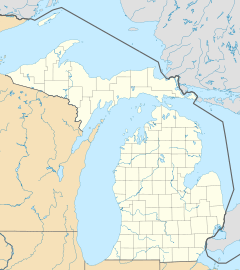Crockery Township, Michigan facts for kids
Quick facts for kids
Crockery Township, Michigan
|
|
|---|---|
|
Township
|
|
| Country | United States |
| State | Michigan |
| County | Ottawa |
| Area | |
| • Total | 33.4 sq mi (86.4 km2) |
| • Land | 32.7 sq mi (84.7 km2) |
| • Water | 0.7 sq mi (1.7 km2) |
| Elevation | 650 ft (198 m) |
| Population
(2020)
|
|
| • Total | 4,572 |
| • Density | 136.89/sq mi (52.92/km2) |
| Time zone | UTC-5 (Eastern (EST)) |
| • Summer (DST) | UTC-4 (EDT) |
| ZIP code | |
| FIPS code | 26-18800 |
| GNIS feature ID | 1626140 |
Crockery Township is a cool place in Ottawa County, Michigan. It's like a small local government area. In 2020, about 4,572 people lived there.
Contents
Exploring Crockery Township's Communities
Crockery Township doesn't have any big cities or towns inside it. But it does have some interesting smaller communities.
Nunica: A Central Spot
- Nunica is a small community right in the middle of the township.
- It's close to where two major roads, Interstate 96 and M-104, meet.
Ottawa Center: A Historic Place
- Ottawa Center was a settlement long ago, located by the Grand River.
- It was even considered to be the main town for the county back in 1856!
Spoonville: A Railroad Stop
- Spoonville was another old settlement.
- It had a train station in 1870, which helped people travel and move goods.
Nearby Towns and ZIP Codes
- The city of Coopersville is to the east. Its ZIP code 49404 covers parts of Crockery Township.
- The village of Fruitport is to the north. Its ZIP code 49415 serves areas in the northwest.
- The village of Spring Lake is to the west. Its ZIP code 49456 covers areas in the southwest.
Geography: Where is Crockery Township?
Crockery Township is surrounded by other townships and a county.
Neighboring Areas
- To the west is Spring Lake Township.
- Muskegon County is to the north.
- Polkton Township is to the east.
- The Grand River forms the southern border.
- South of the river are Allendale Charter Township, Robinson Township, and Grand Haven Charter Township.
Rivers and Creeks
- All the water in the township flows into the Grand River.
- This includes Crockery Creek, which runs through the eastern part of the area.
Size of the Township
- Crockery Township covers about 33.4 square miles (86.4 square kilometers).
- Most of this area, about 32.7 square miles (84.7 square kilometers), is land.
- A small part, about 0.7 square miles (1.7 square kilometers), is water.
People of Crockery Township
Let's look at who lives in Crockery Township.
Population Facts
- In 2000, there were 3,782 people living here.
- About 37% of homes had kids under 18.
- The average age of people in the township was 37 years old.
Income Information
- In 2000, the average income for a family was about $50,219 per year.
- A small number of families and people lived below the poverty line.
History: A Look Back in Time
Crockery Township has a rich history, starting with Native Americans.
Early Inhabitants
- The Ottawa Native Americans lived in this area for many centuries.
- Ottawa County is actually named after this tribe!
European Explorers and Settlers
- The first European explorers, Louis Joliet and Father Jacques Marquette, came through in the mid-1600s.
- More Europeans started settling here in the mid-1800s.
Zinc Discovery and Nunica's Name
- In 1858, people found zinc in Crockery Creek.
- The town of Nunica was officially formed in 1872.
- Its name comes from an Ottawa word meaning "zinc."
- By 1880, about 1,000 settlers lived in the area.
See also
 In Spanish: Municipio de Crockery para niños
In Spanish: Municipio de Crockery para niños

All content from Kiddle encyclopedia articles (including the article images and facts) can be freely used under Attribution-ShareAlike license, unless stated otherwise. Cite this article:
Crockery Township, Michigan Facts for Kids. Kiddle Encyclopedia.


